My title is: Art and Culture | Dance Forms of India | GS 1
Dance Forms of India
India’s rich tradition of different dance forms dates back to ancient times. A number of dance forms are known today. Major dance forms are Bharatnatyam, Kathakali, Kathak, Manipuri, Odissi, Kuchipudi, and Sattriya. A large number of regional dance forms from rural and tribal areas are also known. They are performed on various festivals unique to the region.
History of Dance Forms of India
- Literature
- The literary references for dance go back to Vedas, Puranas, Natakas and Kavyas.
- Present dance forms have evolved from sangeet-natakas (musical plays).
- Natyashastra (also known as the fifth Veda) byBharat Muni is earliest book for the art of dance, drama and music.
- Traditionally, dance and music were combined with drama.
- Excavations
- Mohenjodaro bronze statuette and Harappan broken torso are indicative of dance poses.
- These dance poses are considered precursors of Nataraja (dancing Siva) pose.
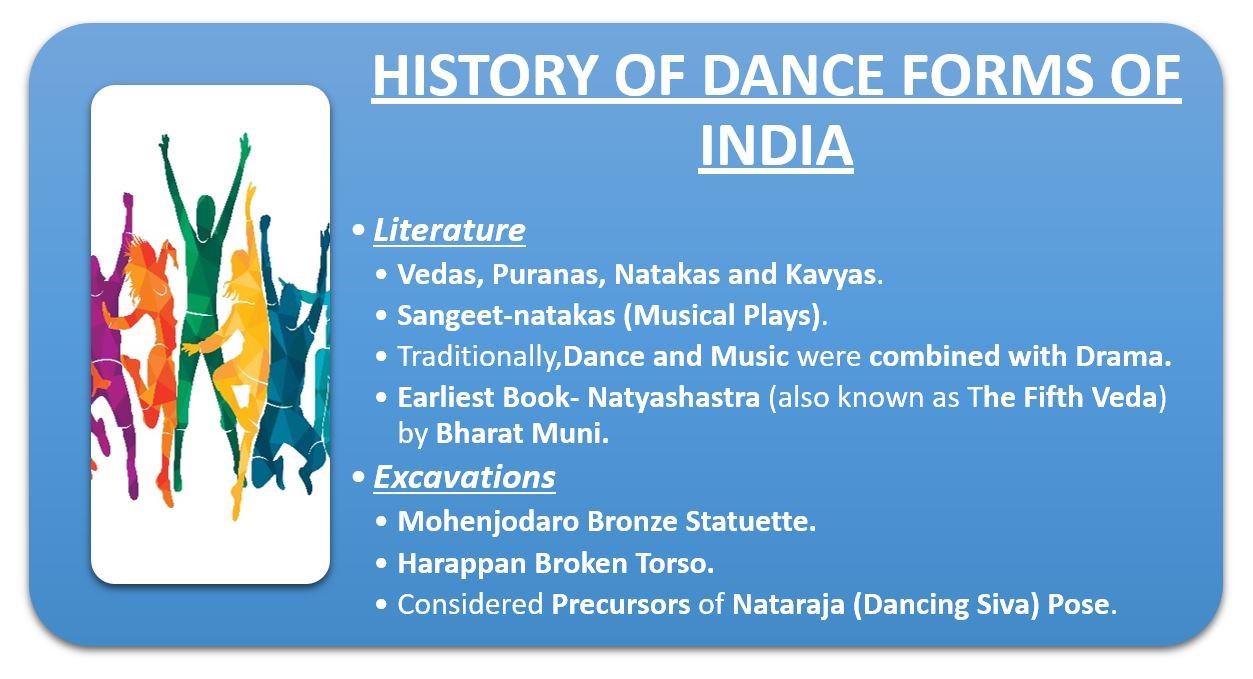
Classical Dance Forms of India
Sangeet Natak Academy has recognized eight classical dance forms. They are Bharatnatyam, Kathakali, Kathak, Manipuri, Odissi, Kuchipudi, Sattriya and Mohiniyattam.
- Bharatnatyam
- Nandikesvara’s Abhinaya Darpana is one main textual source for the study of body movements in Bharatnatyam.
- Bharatnatyam poses are visible on the gopurams of Chidambaram temple and the charis and karanas of this dance are represented in many other temples.
- One dancer accepts many roles in a single performance of this dance. So, the dance is ekaharya.
- The credit for continuation of Bharatnatyam style goes to the devadasis, the young girls who were married to the gods after they were gifted by their parents to the temples.
- In the temples, the devadasis offered the music and dance to the deities.
- During Bharatnatyam performance, an invocation song is followed by first dance item (alarippu, literal meaning- to adorn with flowers), which is a combination of pure dance with the repetition of sound syllables.
- Alarippu is followed by jatiswaram, a short pure dance performed with musical sounds of any raga of Carnatic music. Jatiswaram does not have sahitya (words). It is composed of adavus. Adavus are pure dance series - nritta.
- Jatiswaram is followed by shabdam in the worship of the Supreme Being and the varnam, which is the most important component of the Bharatnatyam performance.
- Varnam includes both nritta and nritya aspects of dances in ancient times and exemplifies the essence of Bharatnatyam.
- In varnam, the dancer shows a complicated wide range of rhythmic patterns in two speeds, and then depicts in a variety of ways, through abhinaya approximately similar to the sahitya.
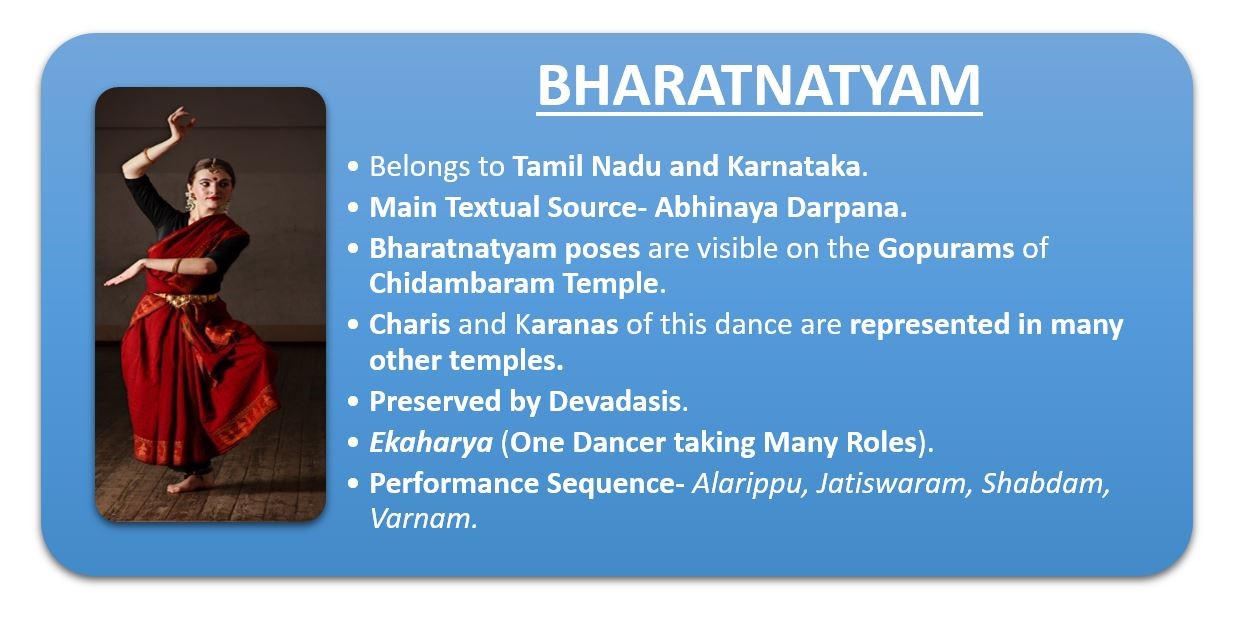
- Kathakali
- It is a dance-drama form of Kerala.
- It is the only classical dance form that emphasizes the Natya aspect of the ancient dance.
- Though it has developed from ancient theatrical forms of the southern region, it is considered to be of recent origin.
- The forms and techniques of Katahkli were directly influenced by Kerala’s ritual performing arts like Chakiarkoothu, Koodiyattam, Krishnattam and Ramanattam.
- Early martial arts from Kerala have influenced movements of body and patterns of choreography specific to Kathakali.
- It combines four aspects of abhinaya- angika, aharya,vachika, satvika with the nritta, nritya and natya aspects.
- In Kathakali, the dancer uses hasta mudras and facial expressions that are codified.
- Hasta mudras and facial expressions are closely followed by the verses (padams).
- Texts like Balarama Bharatam and Hastalakshana Deepika are authoritative for Kathakali.
- During Ilakiattam part of this dance, characters demonstrate their excellence in abhinaya.
- Kathakali music, which also uses Carnatic ragas now, is based on Kerala’s traditional sopana sangeet. It is a ritual singing of the Ashtapadis on steps to sanctum sanctorum.
- Kathakali performance starts with kelikottu, which calls the attention of the audience and is a formal announcement of performance in the evening with drums.
- Todayam, a devotional number calling for blessings of god follows kelikottu. Todayam is followed by the purappadu (a pure nritta), melappada with musicians and drummers and tiranokku, when all characters except the pacha or minukku appear or perform on the stage. Thereafter, the play begins.
|
Character types |
Main Characteristics (All characters wear kirita/headgear) |
|
Pacha (green) |
Kings and divine beings, Make- up is green, Krishna and Rama(wear special crowns with peacock feathers) |
|
Kathi (knife) |
Arrogant and evil beings, Represent anti-heroes, Ravana, Kamsa and Sisupala, Make-up is green with a red marked upturned moustache or painted knife on cheek, White projection on the nose tips and foreheads |
|
Kari (black) |
Wear black costume, Depict a hunter or forest dweller, Black faces with dotted red and white marks |
|
Thaadi (beard) |
Bearded characters like Chuvanna thadi, (red beard), Vella thadi (white beard), Karutha thadi (black beard), Vella thadi ( white beard) |
|
Minukku (radiant) |
Gentle and spiritual like women and sages |

- Kathak
- It probably evolved in the form of oral tradition from Kathakars (story-tellers) of ancient northern India.
- It is the only dance of India that is associated with both Hindu and Muslim culture.
- The Vaishnavite cult and bhakti movement contributed new lyrics and music to Kathak.
- Its popular themes were Radha-Krishna and the works of Mirabai and Surdas.
- It’s important and famous schools are Lucknow Gharana (stressed on bhava), Jaipur Gharana (known for layakari, rhythms) and Benaras Gharana.
- It uses extensive foot-work and is similar to Bharatnatyam, Odissi and Manipuri in terms of pure dance sequences.
- The performance begins with That where the dancer moves neck, eyebrows and the wrists softly, smoothly and continuously, and traditional formal entry called Amad (entry) and Salami (salutation) follow.
- In Kathak, the most unique feature of nritta portion are pirouettes (turns).
- In nritya and abhinaya portions of Kathak, words depict a brief event or group of events from the life of Krishna in short narrative compositions performed in poetic manner and not in lyrical (gata) manner.
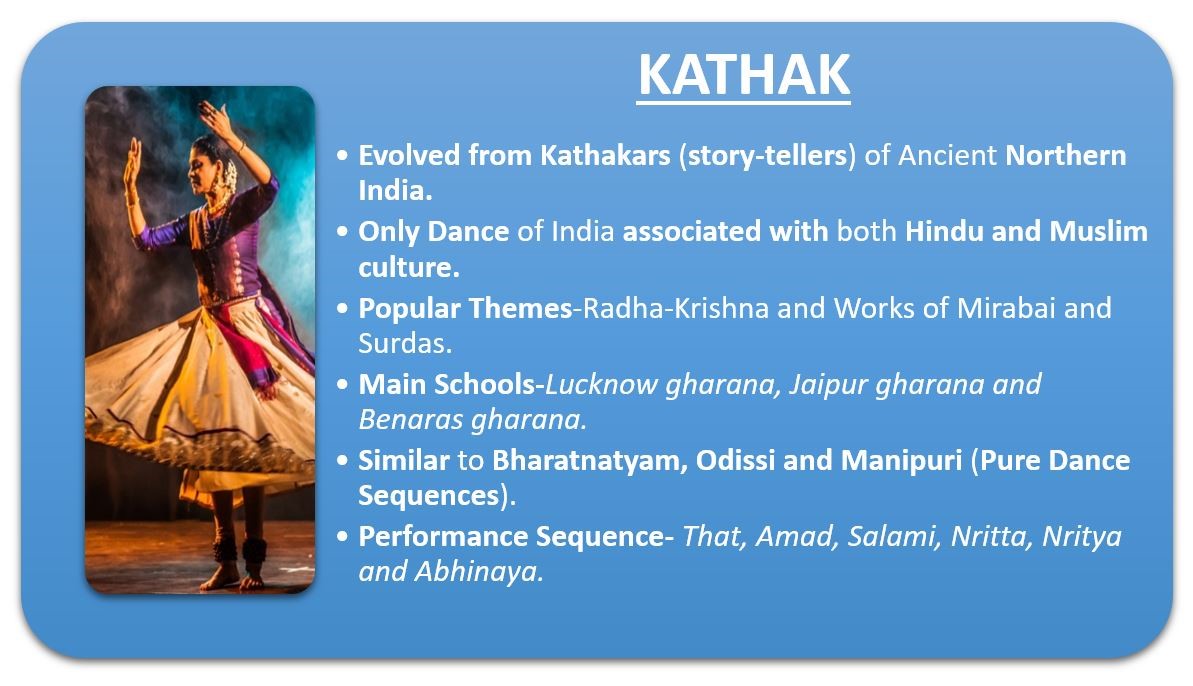
- Manipuri
- Manipuri dance originated in Manipur and is linked with traditional festivals.
- All stylized dances in Manipur are based on Lai Haraoba, the earliest dance and a festival performed in Manipur.
- Rasleela dances originated in the rule of King Bhagyachandra (18th century), who came up with this dance form.
- Ras, Sankirtana and Thang-Ta are the most popular forms of Manipur dance.
- Out of the five main Ras dances, four are linked to specific seasons. Fifth Ras dance can be staged at any time during a year. It is not associated with any specific season.
- In Manipuri Ras, Radha, Krishna and gopis are principal characters and main themes include their separation.
- Clearly defined rhythmic sequences and body movements which are passed on to later generation as part of tradition, are followed by pure dance sequences in Rasleela dance.
- Complex rhythmic patterns are generally overlooked because the dancers do not use ankle bells. They interfere in gentle body movements.
- The Ras costume has an elaborately and plentifully embroidered stiff skirt extending up to the feet with a short fine white muslin skirt over it, a velvet blouse with dark colors covering the upper part of dancer, a traditional white veil covering hairs which fall over the face of performer and jewellery.
- Pung and Kartal played by male dancers while dancing at all social and religious festivals represent the masculine part of dance - the Choloms. They are a part of the tradition known as Sankirtana in Manipur.
- Manipur has many martial dances where the dancers depict real fight scenes using swords, spears and shields. Thang-ta is the martial dance of Manipur.
- Manipur dance contains both tandava and lasya. Manipuri abhinaya does not put much energy into mukhabhinaya. It is characterized by natural facial expressions (not exaggerated). Conveying rasa using the whole body is its strong point.
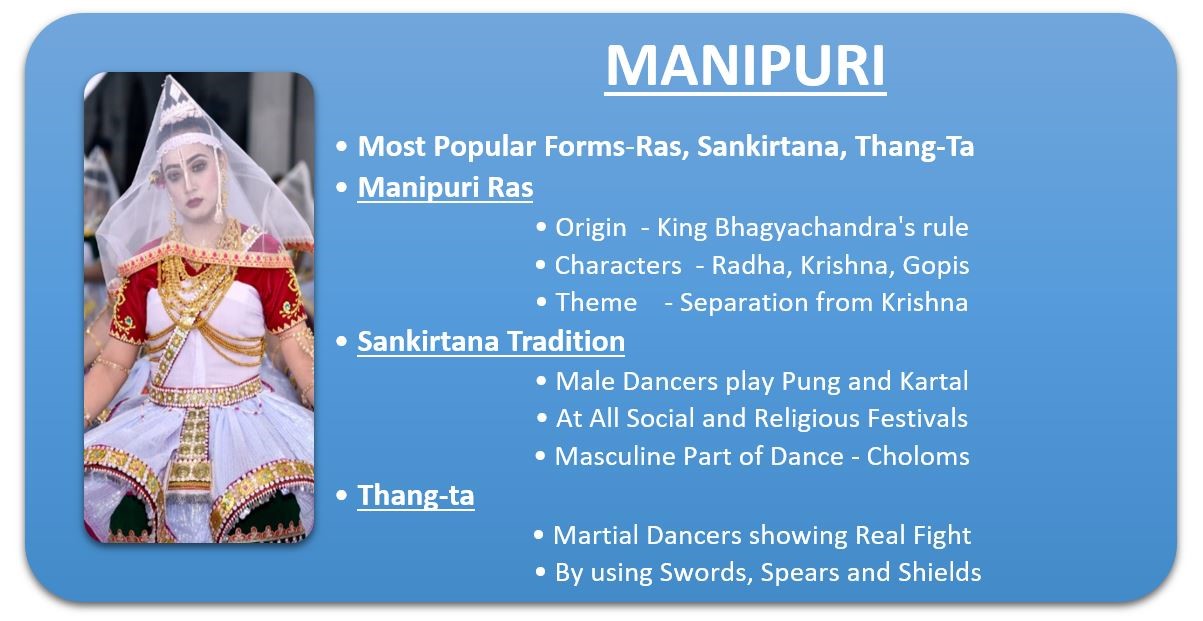
- Odissi
- Odhra Magadha a south-eastern style among many other regional varieties provided in Natya Shastra can be recognized as the earliest predecessor of present-day Odissi dance.
- Archaeological and sculptural evidence of Odissi come from Udayagiri and Khandagiri caves of 2nd century B.C.
- Buddhist sculptures, dancing Yoginis, Nataraja in tantric images of early Shaivite temples provide evidence for the continuation of Odissi from the 2nd century B.C.E to the 10th century C.E.
- Dance movements sculpted at Natya mandap or Hall of dance of 13th century Sun Temple, Konarak inspire Odissi performers even today.
- Temple dancers called maharis performed Odissi for centuries, which degenerated after they were employed in royal courts.
- Later, gotipuas performed this dance in temples and also for general entertainment. Many of today's Odissi gurus rare related to gotipua tradition.
- To some extent, Odissi is based on Natya Shastra, Abhinaya Darpana and 12th century Gita Govinda by Jayadeva provided themes for this dance.
- The body movement techniques are basically based on the Chowk (a very masculine way of standing) and the Tribhanga (very feminine way of standing) postures.
- It’s important and unique feature is the torso movement. Foot positions vary from flat to toe or heel touching stage, and numerous leg movements, jump and turn patterns are possible. These are called as bhangis and end up in one particular way of standing.
- Hand gestures are only decorative features in nritta and nritya; they are employed for communication.
- In Mangalacharan(opening item), the performer slowly makes entry to the stage having flowers in her hands, offers them to mother earth, invokes the deity (generally Ganesha) of her choice, and performs a nritta sequence along with salutations to the God, Guru and the audience.
- The next item, Batu, highlights basic concepts concerning the Odissi nritta technique and brings out masculine and feminine duality.
- After the nritta in Batu, the dancer visually shows with slow and fine movements a musical work in a particular raga in the Pallavi and develops complex patterns to draw attention towards rhythmic changes within the tala. Abhinaya follows the Pallavi.
- The concluding item of performance is called moksha. It may consist of more than one Pallavi and items on the basis of abhinaya.
- Pakhawaj player (usually the Guru), singer, flutist, sitar or violin player and manjira player also take part in Odissi.

- Kuchipudi
- Siddhendra Yogi (a Vaishnava poet) created the Kuchipudi style of very long tradition of dance-drama (Yakshagaana) in Andhra Pradesh.
- Bhaamaakalaapam, composed by Siddhendra Yogi, is till now considered the masterpiece of the Kuchipudi.
- Lakshminarayan Shastry (1886-1956) introduced solo dancing and training of female performers in Kuchipudi style.
- Acrobatic dancing, like dancing above the rim of a brass plate and dancing with a pitcher filled with water on the head was introduced to show skill of dancers in footwork and control and balancing of the body by dancers.
- Two forms of Kuchipudi that exist now are the musical dance-drama (traditional form) and the solo dance form.
- Kuchipudi recital begins with an invocation of deity, which was restricted to Ganesha Vandana earlier. It is followed by non-narrative dancing(nritta). Narrative work called shabdam (Dashaavataara) is presented next. A natya called Kalaapam follows Shabdam.
- A pure nritya abhinaya number comes next. Literary-cum musical forms like padam, jaavli, shlokam, etc. form basis of it
- A Kuchipudi recital concludes with tarangam in which the dancer usually stands on a brass plate and moves it rhythmically with great skill.
- Classical Carnatic music accompanies Kuchipudi.
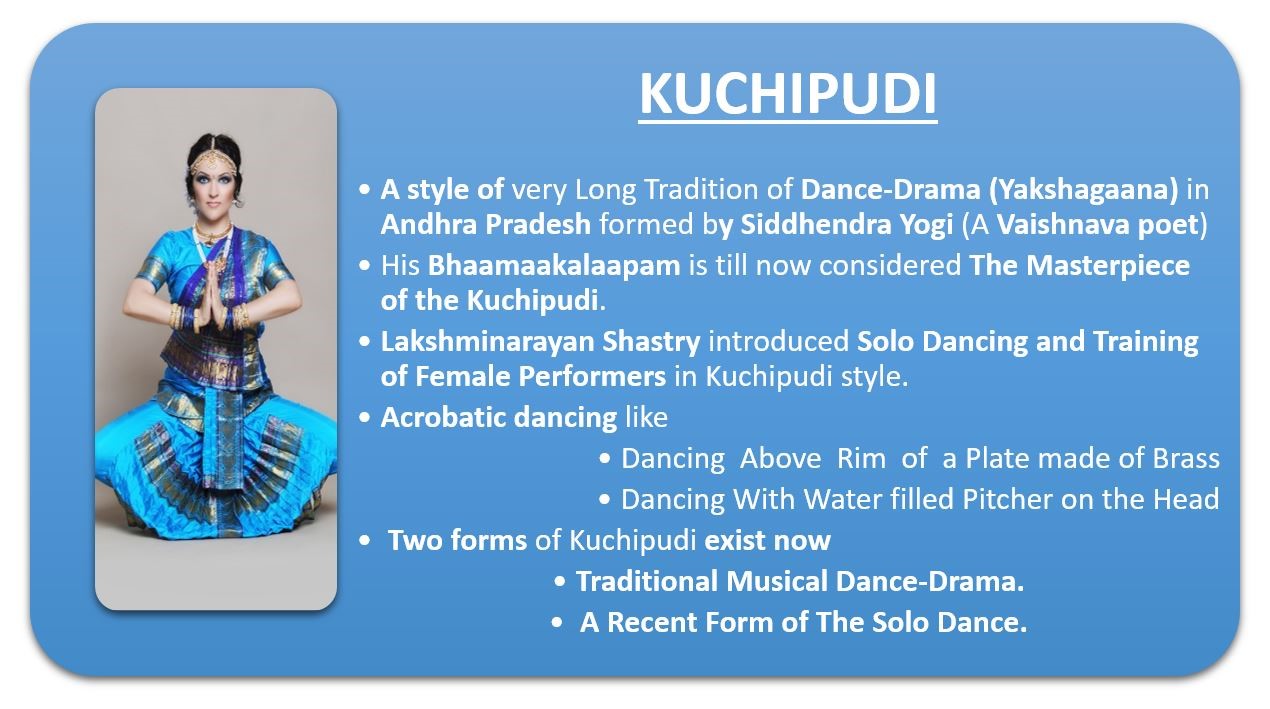
- Sattriya
- Sankaradeva, Vaishnava saint and reformer of Assam introduced it in 15th century A.D.
- This Assamese dance and drama have been preserved by the Sattras (Vaishnava maths or monasteries) for centuries.
- Before the neo-Vaishnava movement, two dance forms (Ojapali and Devadasi) were widespread in Assam.
- Two varieties of Ojapali dances (Sukananni or Maroi Goa Ojah of Sakti cult and Vyah Goa Ojah of Vaishnava cult) are still widespread in Assam.
- Other Assamese folk dances (Bihu, Bodos, etc) have also influenced Sattriya dance.
- Oja paali dancers sing, dance and explain narration by gestures and other stylized movements.
- Rhythmic syllables, dance postures, footwork were influenced by Devadasi dance.
- Sattriya dance tradition has strict principles regarding hasta mudras, footwork, aharyas, music, etc.
- Bhaona-related stream of Sattriya dance tradition starts from the Gayan-Bhayanar Nach to the Kharmanar Nach,
- Independent dance numbers, such as Jhumura, Chali, Rajagharia, Nadu Bhangi, etc. form another stream of Sattriya dance tradition.
- Chali is marked by gracefulness and elegance.
- Jhumura is characterized by vigor and majestic beauty.

- Mohiniyattam
- It is a classical dance form of Kerala.
- It is performed solo and ideally suitable for performance by women.
- It finds mention in Vyavaharamala by Namputiri and in Ghoshayatra by Kunjan Nambiar.
- Graceful, slow, or rhythmic body movements without sudden jerks or leaps are characteristic of this dance form.
- It relates to the lasya style.
- The movements were taken from Nangiar Koothu and female folk dances such as Kaikottikali and the Tiruvatirakali.
- They involve the up and down movement on toes, which are similar to sea waves and the slow or rhythmic movements of trees like the coconut, palm, and like the paddy fields.
- The footwork is done softly. Hand gestures and Mukhabhinaya with fine facial expressions are given importance in Mohiniyattam.
- Mohiniyattam emphasizes on acting.
- The hand gestures are mainly taken from Hastalakshana Deepika. Kathakali also follows this text.
- The traditional sequence includes Chollukettu, Jatiswaram, Padavarnam, Padam, Tillana and Slokam.
- Vallatol introduced Pandattam and Omanatinkal. They are also popular and frequently included in recital.
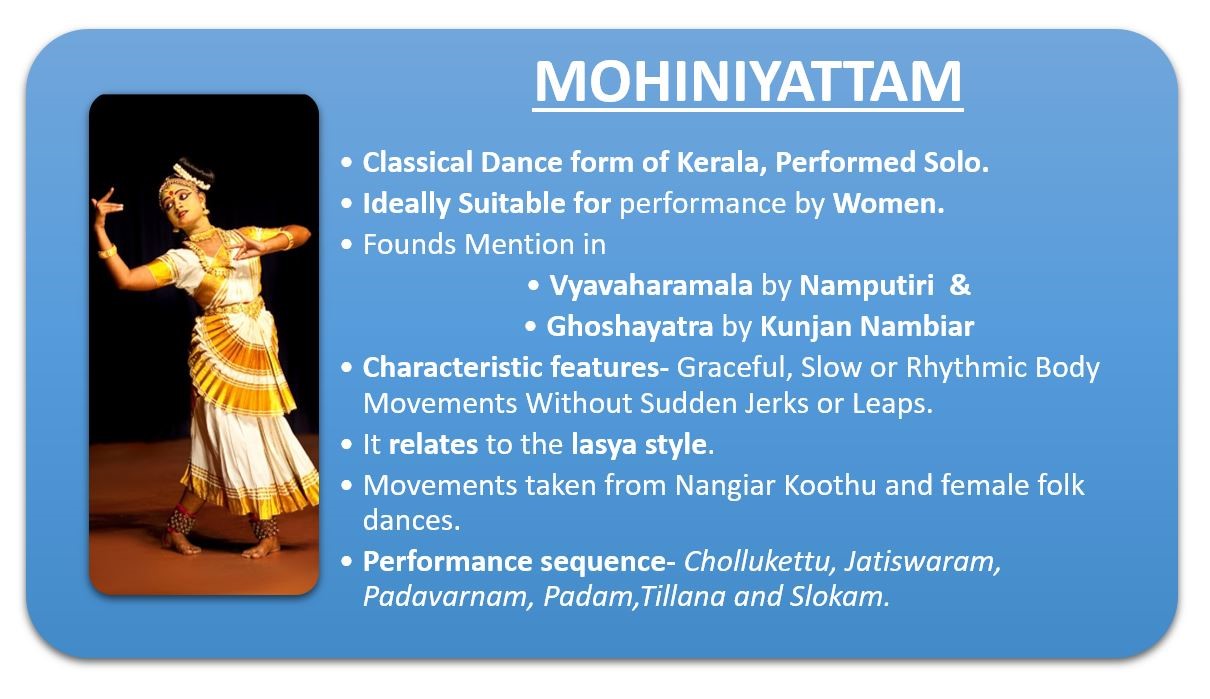
Folk Dances in India
A large number of folk dance forms have been developed and preserved in various regions of India for centuries. These dance forms are a reflection of life and culture of the local people inhabiting particular regions and form crucial part of their life and entertainment. The folk dances are performed during festivals and social occasions like marriage or childbirth. They may be based on the day-to-day life of local people or traditional legends.
|
State |
Folk Dance |
|
Arunachal Pradesh |
Bardo Chham, Ponung, Wancho, Khampti, Daminda, Taapu, Rikhampada, Lion and peacock Dance. |
|
Assam |
Bihu, Bagurumba, Jhumair (also performed in Bangladesh) |
|
Bihar |
Bideshiya (dance-drama), Domkach , Fagua, Jat-Jatin, Jhijhian, Jhumri, Kajari, Painki, Sohar |
|
Chhattisgarh |
Raut Nacha |
|
Goa |
Fugdi |
|
Gujarat |
Garba, Gagari, Ghodakhund, Dandiya, Siddi Dhamal, Tippani, Matukadi, Padhar, Aagaw, Hudo |
|
Haryana |
Ragini, Ras Leela, Gogaji and Gugga, Jhumar |
|
Himachal Pradesh |
Nati, Charba |
|
Jammu and Kashmir |
Neyopa, Bacha Nagma, Dumhal , Rauf |
|
Jharkhand |
Jhumair, Domkach, Jhumar, Mardana Jhumair (Nagpuri folk dance), Janani Jhumair( Nagpuri Folk dance), Lahasua, Fagua, Paika (martial dance), Seraikella Chau, Santali dance, Mundari dance |
|
Karnataka |
Bedara Vesha, Dollu Kunitha, Veeragase, Hulivesha |
|
Kerala |
Thirayattam, Theyyam, Chakyar Koothu, Duffmuttu, Margamkali, Oppana, Padayani, Thitambu Nritham, Thullal |
|
Madhya Pradesh |
Grida, Maanch, Matki dance, Phulpati dance, Tertali, |
|
Maharashtra. |
Lavani, Lezim, Koli dance, Tarpha or Pavri Nach. |
|
Meghalaya |
Derogata, Shad suk mynsiem, Shad nongkrem, Do dru Sua, Laho, Wangala |
|
Mizoram |
Cheraw(Bamboo dance), Sarlamkai, |
|
Nagaland |
The Chang Lo |
|
Odisha |
Dalkhai (Western Odisha), Mayurbhanj Chau, Goti Pua, Baagh Naach, Dhap, Ghumra (Kalahandi folk dance), Karma Naach, Jhumair, Keisabadi |
|
Puducherry |
Garadi |
|
Punjab |
Bhangra, Giddha, Malwai Giddha, Kikkli |
|
Rajasthan |
Dhamal, Ghoomar, Kalbelia, Kachchhi Ghodi, Tera Tali |
|
Sikkim |
Singhi Chham |
|
Tamil Nadu |
Parai Attam(Thappattam), Kummi, Kolattam, Karagattam (Karagam), Mayil Attam(Peacock dance), Paambhu attam (Snake Dance), Oyilattam, Puliyattam, Theru Koothu |
|
Telangana |
Perini Dance |
|
Telangana |
Perini Shivatandavam |
|
Tripura |
Hojagiri |
|
Uttar Pradesh |
Mayur Nritya( Peacock Dance), Rasleela, Charpali, Kajari |
|
Uttarakhand |
Chholiya dance |
|
West Bengal |
Purulia Chau, Domni, Jhumair |
- Bihu
- Bihu is a folk dance from Assam performed in groups with quick steps and fast hand movements with colorful costumes having red color as main theme.
- The origin of Bihu dance date back to sculptures of the 9th century.
- It is named after the national festival of Assam, Bohag Bihu.
- The dance celebrates the fertility of humans and nature.
- Raut Nacha
- This folk dance from Chattisgarh marks worship of Krishna and strongly resembles Krishna's Raas Leela.
- It is performed on the occasion of Dev Udhni Ekadashi. As per Hindu calendar, Dev Udhni Ekadashi is time when Gods awaken after a short rest.
- Garba
- Women usually perform Garba.
- Movements in a circular pattern and clapping in rhythm are part of Garba.
- In combination with Dandiya Raas, Garba has become increasingly popular in the United States.
- This is performed during Navratri.
- Jhumar
- In this dance from Haryana, young girls wear jhumar on their forehead and dance in a circle.
- While dancing, girls also sing songs related to family life.
- This dance is also called Gidda of Haryana.
- Nati
- This dance from Himachal Pradesh is recorded as the largest folk dance in Guinness Book of World Records.
- This dance is also famous in Chandigarh and jounsari community in Uttrakhand.
- Maanch
- This dance is very famous in Malwa in Madhya Pradesh.
- "Maanch" means the place or stage of performance.
- It is performed in a way similar to operatic ballet.
- Lavani
- Lavani is a combination of song and dance in Maharashtra.
- It is performed to the beat of Dholki.
- It is well known for its strong rhythm.
- Lavani has helped in the evolution of Marathi folk theatre.
- Cheraw
- The use of bamboo staves is unique feature of this dance performed in Mizoram.
- This dance is believed to have originated in the 1st century AD and is called Bamboo dance.
- Male dancers beat and move horizontal bamboo staves rhythmically, and female dancers step in and out of them.
- The movements of Cheraw dancers are inspired by natural movements like flying of birds, swaying of trees and the harvesting of paddy.
- Giddha
- This popular folk dance from Punjab is performed by women.
- The performance of this dance involves clapping in rhythm and singing of the traditional folk song.
- This dance is based on ancient ring dance of Punjab and creatively show feminine grace and elegance.
- Kalbelia
- This folk dance from Rajasthan is associated with Rajasthan’s Kalbelia community, a scheduled tribe.
- The movements and costumes of this dance resemble serpents.
- This dance is performed by both men and women and was made a part of UNESCO’s intangible heritage list in 2010.
- Ghoomar
- This folk dance of Rajasthan was performed by the Bhil tribe to worship Goddess Saraswati and was accepted by other communities later.
- This dance is performed at weddings and festivals.
- In this dance, performers turn around while they move in and out of a wide circle.
- Govardan kumari is known for her efforts to promote this dance and was given Padma Shri for her contribution to arts.
- Theru Koothu
- During village festivals in Panguni and Aadi months, Theru Koothu is performed.
- It is famous in northern districts of Tamil Nadu.
- This is done at places of meeting of three or four streets in the late evening by men only. They also play female roles.
- The stories for Theru Koothu are sourced from Puranas and local folk-lore.
- Rasleela
- Rasleela is the most famous form of folk dance in India.
- It is performed during Krishna Janmashtami and Holi and among Gaudiya Vaishnavism followers in Uttar Pradesh.
- It is based on the stories of Lord Krishna.
- Hojagiri
- This dance is performed in Tripura by the people of the Reang community of Tripura.
- Women and young girls (4- 6) move only the lower part of the body while balancing earthen pitcher, a bottle on the head and earthen lamp on the hand.
- The male dancers sing the lyrics, play Kham and Kshumu.
- It is performed on Hojagiri festivals or Laxmi puja.
Popular Blogs
Popular Articles
